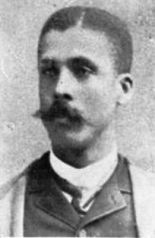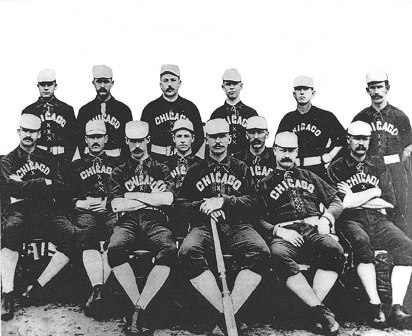The Middle States League lasted just one season, 1889. Not part of the National Agreement, and intended as an eight-team league, the circuit included, at various times, thirteen teams representing cities in Pennsylvania, Delaware, Connecticut, and New Jersey.
The league became integrated with the inclusion of the Cuban Giants of Trenton, who had become the first salaried African-American team four years earlier, and later their biggest rivals, the New York Gorhams (the Gorhams joined the league late, and were expelled in August—they played their home games in Easton, Pennsylvania and Hoboken, New Jersey).
Despite their membership in the league, and the Gorhams’ calling Easton their part-time “home,” both black teams were refused hotel accommodations in Easton during the season.
The relationship between the Cuban Giants and the rest of the league was contentious. In May, The Philadelphia Inquirer said the league’s board of directors charged Cuban Giants’ Manager Stanislaus Kostka (variously nicknamed Cos, S.K., Siki) Govern with violating the league’s $75 a month salary cap by using “players who have not signed regular contracts,” and not using league’s official ball in games. The Inquirer said:
“It appears that the colored club has been running things to suit its own sweet will.”
The paper said after a two-hour meeting Govern promised “to do better in the future.”
The following month the league denied rumors in The Inquirer that “the Cuban Giants were to be forced out on account of their color.” The paper said the August league meeting “was long and mainly occupied by debates between Harrisburg and the Cuban Giants.”
Most of the teams were financially troubled from the outset—at one point a York, Pennsylvania hotel proprietor confiscated the uniforms of the Shenandoah club after the team failed to pay their bill—Shenandoah lasted just 15 games, joining the league in mid July and disbanding August 6.

Advertisement for August, 1889 games between the Lebanon Grays and the Cuban Giants, and Gorhams. The Gorhams were expelled from the league several days after these games were played.
The Harrisburg Ponies were the only team in the league that made money—the Gorhams, according to The Philadelphia Inquirer, had “few paying crowds” in Easton. On August 21 The Inquirer said their “receipts did not amount to more than $20.” The following day they were unable to pay the Hazelton team the guarantee for a scheduled game and were expelled from the league. The Gorhams took to the road and barnstormed for the remainder of the year.
The Cuban Giants didn’t fare much better financially. Owner John Bright, according to The Harrisburg Telegraph, needed to schedule his team for more than 60 exhibition games in addition to the 74 league games in order to turn a profit.
No one who followed the league, including Henry Chadwick, who watched the Cubans Giants play in August, had any doubt which team was the best in the Middle States League. In The Brooklyn Eagle, Chadwick, “The Father of Baseball,” wrote:
“What earnest, active and capable team workers those Cuban Giants are. In fact, I would rather see them play in a game where they had work to do to win than see half the (National) League or American Association teams play. They are well up in the points and they play with a spirit and vigor, and with a good nature withal which makes their field work very attractive. They have very intelligent and gentlemanly young official (manager) in Mr. McGovern [sic]. That catcher of theirs—(Arthur) Thomas—is a character, and they have an excellent strategic pitcher in (William) Seldon, and as for (Frank) Grant, he is at least a second (Fred) Dunlap on the field. In fact, did not see a weak spot in the team in this game.”
Despite playing more than 60 extra games over the course of the season, the Cuban Giants managed to stay neck-and-neck with the Harrisburg Ponies all year. In mid-September, with just four games remaining on the schedule, and with the league’s future in serious doubt, the Cuban Giants, just .001 behind the Ponies chose to cancel their last four games. The Chambersburg Repository said the cancellations allowed “the colored club an opportunity to make a trip through New York State.”
The championship was awarded to the Ponies (who added two more victories after the Cuban Giants departed for New York).
The final official standings:
Harrisburg Ponies 64-19 .771
Cuban Giants 55-17 .764
Cuban Giants owner John Bright protested the final standings and took his case to the press. In a long letter, published in The New York Sun, and other papers, Bright said his team “justly and honestly won” the pennant. He claimed that Harrisburg was incorrectly awarded three victories for forfeited games–one against the Gorhams, when neither team showed up for the game, and two games against Wilmington after that team had disbanded.
Bright also charged that Harrisburg also lost a September game to Lebanon, and after the fact “Harrisburg turns it in as an exhibition game.” He said his team was stripped of two victories in games where the official league ball was not used, while there were two games they lost while playing with the wrong ball “but much to our amazement, only one game was not counted.” Additionally, Bright claimed the league failed to award the Cuban Giants two games won against the Hazelton team.
Bright said the league standings should have been:
Cuban Giants 57-16 .780
Harrisburg Ponies 61-20 .753
Bright concluded:
“So any fair-minded person can see at a glance that the Cuban Giants are the real champions.”
The Philadelphia Inquirer initially seemed to side with the Cuban Giants. They printed Bright’s charges and quoted an unnamed “prominent manager of the Middle States League” who said:
“The Giants are right in a number of their claims. I never could see upon what grounds the Harrisburg club could claim a number of the games complained of, more than by the bulldogging tactics that they always employed throughout the season.”
The Philadelphia Press was squarely in the Harrisburg camp. The paper referred to Bright’s “several foolish claims for the pennant,” and provided a forum for league president William Voltz-who was also the paper’s baseball editor–to respond. Voltz called Bright’s charges “unwarranted and untrue.” The league president/baseball editor also claimed the Cuban Giants still owed the league money and that the proper time for bright to protest the championship would be at the league meeting in December.
Newspaper reports of the December meeting make no mention of any representative of the Cuban Giants appealing the championship.
Harrisburg remains the official champion of the 1889 Middle States League
The league was reconstituted as the Eastern Interstate League for 1890. The nucleus of the Cuban Giants jumped from Bright’s club and joined the league as the York Colored Monarchs—Frank Grant and Clarence Williams joined the previously all white Harrisburg Ponies. The six-team league struggled, quickly became a four-team league, and folded all together in July.
York was leading the Eastern Interstate League when it disbanded.





